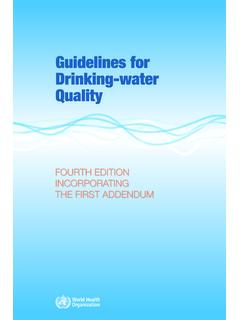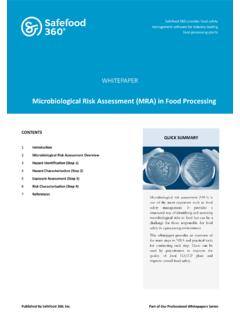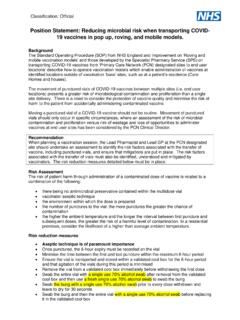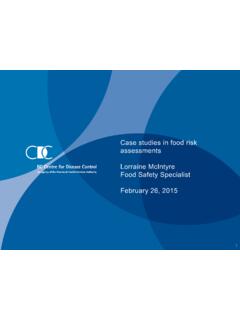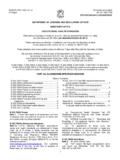Transcription of Annex 1 : Manufacture of Sterile Products 2 Document map
1 1 Annex 1 : Manufacture of Sterile Products 1 2 Document map 3 Section Number General overview 1. Scope Includes additional areas (other than Sterile Products ) where the general principles of the Annex can be applied. 2. Principle General principles as applied to the Manufacture of Sterile Products . 3. Pharmaceutical Quality System (PQS) Highlights the specific requirements of the PQS when applied to Sterile Products . 4. Premises General guidance regarding the specific needs for premises design and also guidance on the qualification of premises including the use of Barrier Technology. 5. Equipment General guidance on the design and operation of equipment. 6. Utilities Guidance with regards to the special requirements of utilities such as water, gas and vacuum. 7. Personnel Guidance on the requirements for specific training, knowledge and skills. Also gives guidance to the qualification of personnel.
2 8. Production and specific technologies Discusses the approaches to be taken with regards to aseptic and terminal sterilization processes. Discusses approaches to sterilization of Products , equipment and packaging components. Also discusses different technologies such as lyophilization and Form-Fill-Seal where specific requirements apply. 9. Viable and non-viable environmental and process monitoring This section differs from guidance given in section 4 in that the guidance here applies to ongoing routine monitoring with regards to the design of systems and setting of action limits alert levels and reviewing trend data. The section also gives guidance on the requirements of Aseptic Process Simulation (APS). 10. Quality control (QC) Gives guidance on some of the specific Quality Control requirements relating to Sterile Products .
3 11. Glossary Explanation of specific terminology. 4 5 2 1 Scope 6 7 The Manufacture of Sterile Products covers a wide range of Sterile product types (active substance, 8 Sterile excipient, primary packaging material and finished dosage form), packed sizes (single unit to 9 multiple units), processes (from highly automated systems to manual processes) and technologies ( 10 biotechnology, classical small molecule manufacturing and closed systems). This Annex provides 11 general guidance that should be used for the Manufacture of all Sterile Products using the principles of 12 Quality Risk Management (QRM), to ensure that microbial, particulate and pyrogen contamination is 13 prevented in the final product. 14 15 QRM applies to this Document in its entirety and will not be referred to in specific paragraphs. Where 16 specific limits or frequencies are written, these should be considered as a minimum requirement.
4 They 17 are stated due to regulatory historical experience of issues that have previously been identified and 18 have impacted the safety of patients. 19 20 The intent of the Annex is to provide guidance for the Manufacture of Sterile Products . However, 21 some of the principles and guidance, such as contamination control strategy, design of premises, 22 cleanroom classification, qualification, monitoring and personnel gowning, may be used to support 23 the Manufacture of other Products that are not intended to be Sterile such as certain liquids, creams, 24 ointments and low bioburden biological intermediates but where the control and reduction of 25 microbial, particulate and pyrogen contamination is considered important. Where a manufacturer 26 elects to apply guidance herein to non- Sterile Products , the manufacturer should clearly Document 27 which principles have been applied and acknowledge that compliance with those principles should be 28 demonstrated.
5 29 30 2 Principle 31 32 The Manufacture of Sterile Products is subject to special requirements in order to minimize risks of 33 microbial, particulate and pyrogen contamination. The following key areas should be considered: 34 35 i. Facility, equipment and process design should be optimized, qualified and validated 36 according to the relevant sections of the Good Manufacturing Practices (GMP) guide. 37 The use of appropriate technologies ( Restricted Access Barriers Systems (RABS), 38 isolators, robotic systems, rapid microbial testing and monitoring systems) should be 39 considered to increase the protection of the product from potential extraneous sources of 40 particulate and microbial contamination such as personnel, materials and the surrounding 41 environment, and assist in the rapid detection of potential contaminants in the 42 environment and product.
6 43 44 ii. Personnel should have adequate qualifications and experience, training and attitude with a 45 specific focus on the principles involved in the protection of Sterile product during the 46 manufacturing, packaging and distribution processes. 47 48 iii. Processes and monitoring systems for Sterile product Manufacture should be designed, 49 commissioned, qualified and monitored by personnel with appropriate process, engineering 50 and microbiological knowledge. 51 52 Processes, equipment, facilities and manufacturing activities should be managed in accordance 53 with QRM principles to provide a proactive means of identifying, scientifically evaluating and 54 controlling potential risks to quality. Where alternative approaches are used, these should be 55 supported by appropriate rationales and risk assessment and should meet the intent of this Annex .
7 56 QRM priorities should include good design of the facility, equipment and process in the first instance, 57 then implementation of well-designed procedures, with monitoring systems as the final element that 58 3 demonstrate that the design and procedures have been correctly implemented and continue to perform 59 in line with expectations. Exclusively monitoring or testing does not give assurance of sterility. 60 61 Quality Assurance is particularly important, and Manufacture of Sterile Products must strictly 62 follow carefully established and validated methods of Manufacture and control. A Contamination 63 Control Strategy (CCS) should be implemented across the facility in order to define all critical control 64 points and assess the effectiveness of all the controls (design, procedural, technical and 65 organisational) and monitoring measures employed to manage risks associated with contamination.
8 66 The CCS should be actively updated and should drive continuous improvement of the manufacturing 67 and control methods. 68 69 Contamination control and steps taken to minimize the risk of contamination from microbial and 70 particulate sources are a series of successively linked events and measures. These are typically 71 assessed, controlled and monitored individually but their collective effectiveness should be considered 72 altogether. 73 74 The development of the CCS requires thorough technical and process knowledge. Potential 75 sources of contamination are attributable to microbial and cellular debris ( pyrogen, endotoxins) as 76 well as particulate matter ( glass and other visible and sub-visible particulates). 77 Elements to be considered within a documented CCS should include (but are not limited to): 78 79 i. Design of both the plant and processes. 80 81 ii. Premises and equipment.
9 82 83 iv. Personnel. 84 85 v. Utilities. 86 87 vi. Raw material controls including in-process controls. 88 89 vii. Product containers and closures. 90 91 viii. Vendor approval such as key component suppliers, sterilization of components and single 92 use systems (SUS), and services. 93 94 ix. For outsourced services, such as sterilization, sufficient evidence should be provided to the 95 contract giver to ensure the process is operating correctly. 96 97 x. Process risk assessment . 98 99 xi. Process validation. 100 101 xii. Preventative maintenance maintaining equipment, utilities and premises (planned and 102 unplanned maintenance) to a standard that will not add significant risk of contamination. 103 104 xiii. Cleaning and disinfection. 105 106 xiv. Monitoring systems - including an assessment of the feasibility of the introduction of 107 scientifically sound, modern methods that optimize the detection of environmental 108 contamination.
10 109 110 xv. Prevention trending, investigation, corrective and preventive actions (CAPA), root cause 111 determination and the need for more comprehensive investigational tools. 112 113 4 xvi. Continuous improvement based on information derived from the above. 114 115 The CCS should consider all aspects of contamination control and its life cycle with ongoing and 116 periodic review resulting in updates within the quality system as appropriate. 117 118 The manufacturer should take all steps and precautions necessary to assure the sterility of the 119 Products manufactured within its facilities. Sole reliance for sterility or other quality aspects should 120 not be placed on any terminal process or finished product test. 121 122 3 Pharmaceutical Quality System (PQS) 123 The Manufacture of Sterile Products is a complex activity that requires specific controls and 124 measures to ensure the quality of Products manufactured.










